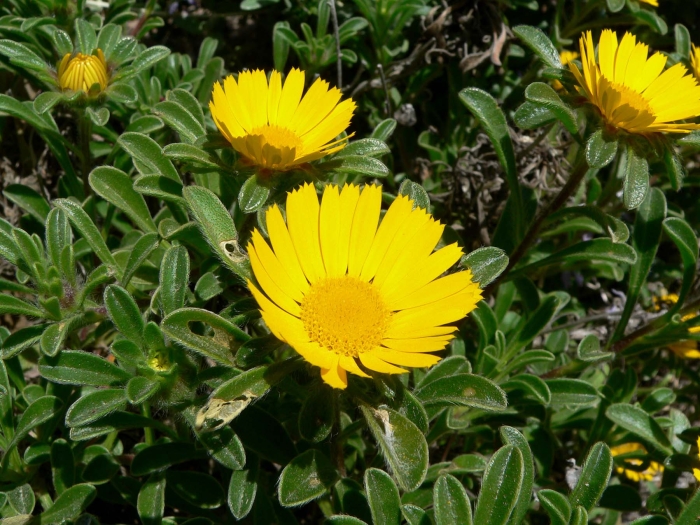Gold Coin Daisy
(Pallenis maritima)
Gold Coin Daisy (Pallenis maritima)
/
/

Stan Shebs
CC BY-SA 3.0
Image By:
Stan Shebs
Recorded By:
Copyright:
CC BY-SA 3.0
Copyright Notice:
Photo by: Stan Shebs | License Type: CC BY-SA 3.0 | License URL: https://creativecommons.org/licenses/by-sa/3.0 | Uploader: Stan Shebs | Publisher: Wikimedia Commons | Title: Asteriscus_maritimus_flowers.jpg | Notes: == {{int:filedesc}} == {{Location|15|21|55|S|47|27|08|W|scale:20000}} {{Information |Description= {{en|Two young [[:en:Pandanus utilis|common screwpines]] ''(Pandanus utilis)'' in the park of [[:en:Itiquira Falls|Itiquira Falls]] near [[:en:Formosa |













































Estimated Native Range
Summary
Pallenis maritima, commonly known as Gold Coin Daisy, is an evergreen subshrub native to coastal areas and sandy soils of the Mediterranean region. It typically grows to a height of up to 30 cm and can spread to about 45 cm wide. The plant forms a low mound and is characterized by its lance-shaped, silvery-green leaves. Gold Coin Daisy produces vibrant yellow flowerheads with darker yellow centers from late spring to early summer, which are highly attractive to pollinators. The flowers are quite showy and can add a splash of color to the garden during their blooming season.
Gold Coin Daisy is valued for its drought tolerance and ability to thrive in poor soils, making it an excellent choice for xeriscaping and seaside gardens. It is often used in rock gardens, as ground cover, and in containers where its bright flowers can be appreciated up close. For successful cultivation, it requires well-drained, sandy soil and should be placed in a location with full sun exposure. While it prefers moderate moisture, it is quite tolerant of dry conditions once established. Propagation is typically done by seed or cuttings, and the plant is known for its ease of maintenance. Gardeners should be aware that in very wet conditions, Pallenis maritima may suffer from root rot.CC BY-SA 4.0
Gold Coin Daisy is valued for its drought tolerance and ability to thrive in poor soils, making it an excellent choice for xeriscaping and seaside gardens. It is often used in rock gardens, as ground cover, and in containers where its bright flowers can be appreciated up close. For successful cultivation, it requires well-drained, sandy soil and should be placed in a location with full sun exposure. While it prefers moderate moisture, it is quite tolerant of dry conditions once established. Propagation is typically done by seed or cuttings, and the plant is known for its ease of maintenance. Gardeners should be aware that in very wet conditions, Pallenis maritima may suffer from root rot.CC BY-SA 4.0
Plant Description
- Plant Type: Subshrub
- Height: 0.8-1 feet
- Width: 0.8-1 feet
- Growth Rate: Moderate
- Flower Color: Yellow
- Flowering Season: Spring, Summer
- Leaf Retention: Evergreen
Growth Requirements
- Sun: Full Sun
- Water: Medium
- Drainage: Fast
Common Uses
Border Plant, Groundcover, Low Maintenance, Salt Tolerant
Natural Habitat
Coastal areas and sandy soils of the Mediterranean region
Other Names
Common Names: Golden Coin Daisy, Mediterranean Beach Daisy, Estrella De Mar
Scientific Names: , Pallenis maritima, Asteriscus maritimus f. maritimus, Asteriscus maritimus var. villosissimus, Asteriscus maritimus var. discoideus, Asteriscus maritimus var. lanuginosus, Asteriscus maritimus var. maritimus, Asteriscus maritimus var. microphyllus, Asteriscus maritimus var. parviflorus, Asteriscus maritimus var. perpusillus
GBIF Accepted Name: Pallenis maritima (L.) Greuter